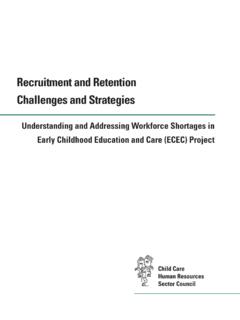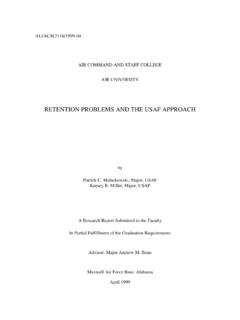Transcription of Staff Recruitment and Retention Challenges in Child Care
1 Shedding New Light onStaff Recruitment and RetentionChallenges in Child CarePrepared for the Child Care HumanResources Sector CouncilAuthors: Gillian Doherty, Barry ForerShedding New Light onStaff Recruitment and RetentionChallenges in Child CarePrepared for the Child Care HumanRe sources Sector CouncilAuthors: Gillian Doherty, Ba r ry ForerTo obtain additional copies of this report, please contact: 866-411-6960 Child Care Human Resources Sector Council323 Chapel Street, 3rd FloorOttawa (ON) K1N project is funded by the Governmentof Canada's Sector Council opinions and interpretations in this publication are those of the author and do notnecessarily reflect those of the Government of NEW LIGHT ON Staff Recruitment AND Retention Challenges IN Child CAREiThe Child Care Human Resources Sector Council (CCHRSC)
2 Welcomes the opportunity to sharethis timely and topical report with New Light on Staff Recruitment andRetention Challenges was commissioned by the CCHRSC a pan-Canadian, non-profitorganization dedicated to moving forward on human resource issues in the Child care study focuses on further, more in-depth analysis of data collected from Child care centresfor the2001 You Bet I Care! (YBIC) project, a study well known to our findings of the Wor k in g for Changereport are especially relevant now, at a time when Child careis high on the government agenda. As we move into a period of promised government commitment,the momentum needed to propel the Child care agenda forward is building. Political will, coupled withthe knowledge and experience of Child care advocates, is necessary to effectively address the manychallenges facing the sector and its the country, Child care workers contend with issues ranging from low income levels; fewbenefits; a lack of respect and recognition; little support; and barriers to training.
3 In a sector thatrequires an immense physical and emotional investment, failure to address these human resource issueshas led to high levels of burnout and frustration among Staff . In turn, the challenge of recruiting andretaining a skilled Child care workforce has become increasingly difficult. Today, the Child care sectoris facing a Recruitment and Retention crisis. As the Shedding New report shows, the long-termabsence of adequate public policy and funding have resulted in the low wages and poor workingconditions that plague the sector. This makes it very difficult to attract a potential workforce and retainthe existing one. With a large number of Child care workers moving out of the field for higher wagesand improved working conditions, Canada faces a critical Child care labour more than ever, there is a serious need to reevaluate Canada s approach to Child care.
4 The answerto meeting Child care needs rests in improved policy, funding, and support for the workforce. This canonly be accomplished through the development of a well supported and publicly funded Child caresystem. The work of the CCHRSC, together with all Child care, labour, and advocacy organizations, isto bring evidence-based research to light and use it as a foundation for CCHRSC would like to express our heartfelt gratitude to Gillian Doherty and Barry Forer,whose effort and dedication made this report a reality. To the Child care centre Staff and directorsacross Canada who so generously contributed their time and experience, our deepest respect andadmiration. A special thank you to the original YBIC! project research team Doherty, Lero, Goelman,LaGrange, and Tougas and to the CCHRSC project Working Group who provided support andguidance throughout the project.
5 Our sincere appreciation to Human Resources DevelopmentCanadafor funding this study and for continuing to support the work of the FROMTHE Child CARE HUMAN RESOURCES SECTOR COUNCILSHEDDING NEW LIGHT ON Staff Recruitment AND Retention Challenges IN Child CAREThe authors would like to acknowledge the contribution of thechild care centre Staff and directors across Canada who generouslygave of their time to complete the lengthy questionnaires that werepart of the Yo u Bet I Care!project and produced the data used inthis study. Without them, it would have been impossible toundertake the analyses of predictors of Recruitment and retentionchallenges that we report in this paper. We would also like toacknowledge the research team that conducted the Yo u Bet I Care!
6 ACanada-Wide Study on Wages, Working Conditions and Practices inChild Care paper greatly benefited by review of the initial draft andsuggestions from the working group supervising this study. Themembers were: Sheila Davidson, Gyda Chud, Raymonde Leblanc,Jasbir Randhawa and Trista u Bet I Care! A Canada-Wide Study on Wages, Working Conditionsand Practices in Child Care Centreswas funded by the Child CareVisions Program of the Employability and Social Partnershipsdivision of Human Resources Development Canada. Theadditional work reported in this paper was funded by SocialDevelopment Canada, and confirms its strong support for thechild care NEW LIGHT ON Staff Recruitment AND Retention Challenges IN Child CARE1 Message from the Child Care Human Resources Sector CounciliAcknowledgementsiiTa bl e of contents1 Executive Summary5 Chapter 1 of the this report is organized9 Chapter 2:Intention to Leave the Centre, Centre Difficultiesin Retaining Staff and Centre of the of intention to leave the centre12 The link between expressing intent to leave and actually doing so Methodology of a centre having Staff Retention difficulties of centre turnover 3.
7 Intent to leave the r v i ew of the e of individuals expressing an intention to leave the field17 Methodology Findings Would not choose Child care as a career nowTA BLE OF CONTENTS2 SHEDDING NEW LIGHT ON Staff Recruitment AND Retention Challenges IN Child CARETABLE OF re d ic tors of the proportion of Staff in a centre who intend to leave the field u mmary21 Chapter 4:Centres experiencing Staff Recruitment 2 Ove r v i ew o f f i n d i n g s234. 3Th e of Recruitment u mmary24 Chapter 5:Moving v iew of the con tent and format of this and benef it romotion opportunities26 to acquire perception of a lack of respect for the importance of a positive organizational key role of the Burnout28 What is burnout?
8 Contributors to Staff burnout29 Early indications that a Staff member is burning out29 Combating Towards a solution31 SHEDDING NEW LIGHT ON Staff Recruitment AND Retention Challenges IN Child CARETABLE OF CONTENTS3 Appendix A :Original list of potential predictors of intention to leave:33 The centre within one year. The Child care field within three yearsAppendix B : Original list of potential predictors for:43 Turnover Keeping qualified permanent teaching Staff is a major problem Finding qualified permanent teaching Staff is a major problemAppendix C :List of potential predictors at the individual Staff level with a correlationof .1 or higher with intention to leave:55 The Child care field within three years The centre within one yearAppendix D : List of potential predictors at the centre level with a correlationof.
9 1 or higher with intention to leave:59 The Child care field within three years The centre within one yearAppendix E :List of potential predictors with a correlation of .1 or higher for:63 Turnover Keeping qualified permanent teaching Staff is a major problem Finding qualified permanent teaching Staff is a major problemReferences67 Glossary71 LIST OF TABLES4 SHEDDING NEW LIGHT ON Staff Recruitment AND Retention Challenges IN Child CAREE xecutive of all seven Retention and Recruitment outcomes6 Chapter :Predictors of intention to leave the : Predictors of centres where retaining Staff is a major problemwhen the already-determined predictor of actual turnover ratein the previous 12 months is of centre turnover strongest predictors for each of three situations and their importance scores16 Chapter :Predictors of an individual intending to leave the.
10 Predictors of an individual intending to leave the field when thealready-determined predictors of would not choose Child care as a career and I feel frustrated by this job are : Predictors of an individual stating that they would not choose Child care as a career :Predictors of the proportion of Staff in a centre who intend to leave the :Predictors of the proportion of Staff in a center indending to leave the field after the already-determined predictor would not choose Child care again as a career is : Summary of predictors of intention to leave the field and their relative importance21 Chapter : Predictors of problems in recruiting permanent, qualified of problems recruiting permanent, qualified staffwhen the already-determined predictor of turnover rate is removed24 Chapter nd icators of Staff burnout as predictors of intention to leave the centreand of intention to leave the field29 SHEDDING NEW LIGHT ON Staff Recruitment AND Retention Challenges IN Child CARE5 This study undertook additional analyses of data originally collectedfor the 1998 Yo u Bet I Care!











